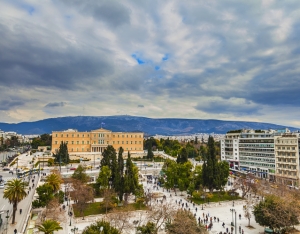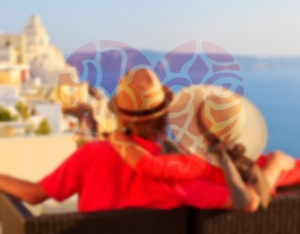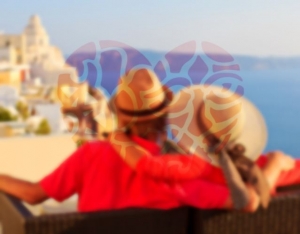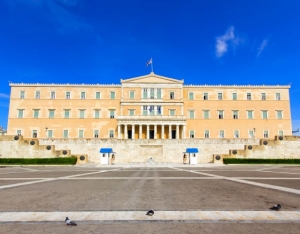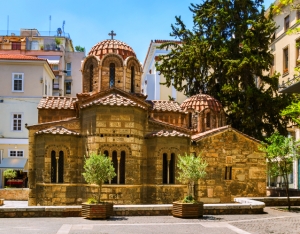Thodoris Bgenopoulos
In front of the Greek Parliament, right in the heart of Athens, you will find Syntagma Square, which together with Omonia Square are the main squares of Athens.
It was originally called the Palace Square, as the building that now houses the Greek Parliament, was once the Old Palace and residence of King Otto. After the Revolution of the 3rd September 1843, when the army and the citizens gathered in the square together, forcing Otto to grant them a constitution, the square changed name to Syntagma (=Constitution) Square.
Around the square you will find some of the top hotels in Athens, while the square is a hub for public transport with trolley bus stops, buses and subway station. Therefore, it is no surprise that the meeting point for Athenians coming from different areas is Syntagma, as this is how Syntagma Square is called for short.
Akadimia (College) - Panepistimio (University) - Vivliothiki (Library) in Athens
21 February 2015Three of the most beautiful buildings in Athens are located a few meters from Syntagma Square, in Panepistimiou Street. The University of Athens, the Athens Academy and the National Library are also called "Neoclassical Trilogy of Athens". The Academy and the Library are works of the famous Danish architect Theophil Hansen, while the third, the University, is also a work by the Hansen family, as it is his brother, Christian, who was responsible for it.
Although these three buildings were designed and situated almost at the same time, they were not built together, probably for economic reasons.
The University of Athens preceded the rest. The main building of the University was founded in 1839 and by 1842 had its front wing complete. The rest of the building was gradually complete until 1864.
Following on, the Athens Academy was founded in 1859 and completed in 1885. The building is Ionic and upon its two tallest columns on either side of the building, there are the statues of Athena and Apollo.
Last but surely not least, the National Library was founded in 1887 and completed in 1902, thus creating the trilogy envisioned by Hansen.
Even today, the three buildings that make up the Neoclassical Trilogy still shake visitors with their beauty and still among the most photographed locations in Athens.
The Monastery of Daphni is in Haidari, 11 km from the city center towards Eleusina.
In the premises of Daphni Monastery, the church of Dafneiou Apollo predated. It was right upon the ancient engraving of the Sacred Road that connected Athens and Eleusina, and thereby gave its name to the area. The new church was built in 5 AD, upon the ruins of the old temple, as the Christians used to. Actually, one of the temple's columns was used as a column in the new church that stands tall up until the present day.
In 1205, the monastery was plundered by the Crusaders and ceded to French monks. These were later expelled by the Turks and the Daphni Monastery was granted again to Greek Orthodox monks, but unfortunately was gradually deserted. The restoration work began in 1900, while the Daphni Monastery suffered several losses from the great earthquake in Athens in 1999.
The Daphni Monastery is a typical Byzantine monument and is distinguished by its unique architecture and unique mosaic decoration. All these elements contributed to the decision in 1990 that Daphni Monastery ought to be protected by UNESCO as a Monument of Cultural Heritage.
The Kaisariani Monastery is approximately 6 km from the center of Athens, in an area full of green.
It is one of the oldest monasteries in Attica, being built in 11th century AD. The Kaisariani Monastery was dedicated to Virgin Mary and in 1833 was shut down by order of the king. It is worth the visitor's attention, both for its architecture and for the very special place where it is situated. Build within a green environment, in a very quiet place almost beside the bustling capital Athens, it has a unique character. From the Byzantine period, the nave and baths are preserved, while its oldest fresco dates to the 14th century.
Visiting Kaisariani Monastery can be combined with a lovely walk in the woods and mountains of Hymettus for those who love nature and its beauty. Access to the site is allowed only from sunrise to sunset.
The Tomb of the Unknown Soldier is in front of the Palace of the Greek Parliament, in the center of Athens.
The monument is very simple and it consists of a sculpture in which a naked warrior with helmet and shield in hand is sprawled, symbolizing the soldiers' sacrifice in battle. The monument is dedicated to all those soldiers whose names were never known and were not recorded in history, yet with their sacrifice they ensured life and freedom to the remaining Greeks.
The monument is guarded honorary by the famous presidential guard, the Evzones or otherwise known as tsoliades. The Evzones are an elite military corps with characteristic traditional clothing (foustanela, rustic shoes), whose members stand vigilant guards in front of the Tomb of the Unknown Soldier.
Almost every visitor of Athens has a photo with the evzone in front of the Tomb of the Unknown Soldier, and whoever doesn't... should get one.
The Greek Parliament House (less known as the Old Royal Palace) is in front of Syntagma Square, in the heart of Athens.
The building was constructed between 1836 – 1847, in order to host the royal couple of Otto and Amalia. The palace (as it was called) was built to designs by the Bavarian architect Friedrich von Gaertner, while it was funded by Otto's father, King Ludwig I of Bavaria.
This is a three-story neoclassical building, rectangular in shape and huge, built primarily of marble, stone and wood.
The building ceased to be used as a palace and official residence of the royal family in 1910. From 1929 on, it became the seat of the Greek Parliament that was previously housed in the building at Stadiou Street , where today is the National History Museum. The building since then, now known as the Greek Parliament, has been the birthplace of Democracy in the city that the gave birth to the idea itself.
On the west side of the Palace of the Greek Parliament, is situated the famous Tomb of the Unknown Soldier.
In the middle of Ermou Street, between Syntagma and Monastiraki is a small church, Kapnikarea.
The church was built in the mid-11th century, probably upon the ruins of another 4th century church, which in turn was built upon an ancient temple. On the church walls, you can distinguish pieces of marble and columns belonging to buildings of an older era.
The church, according to some, was named Kapnikarea probably from the family Kapnikari that arranged its construction.
The most recent murals in Kapnikarea are the hagiographies of 1955, which have the signature of Fotis Kontoglou, a significant Greek hagiographer.
In 1834 there was a demolition project of Kapnikarea, to enable the widening of the road. Luckily, the project was canceled last minute with the intervention of King Otto's father, Ludwig of Bavaria.
Between Syntagma and Monastiraki, at Mitropoleos street, you will find Metropolis, the Cathedral of Athens.
The construction of the church began in 1842 and until its completion both the plans and the architect changed, so the final building has a very special architectural character. The Metropolis was completed in 1862 and since then is the main temple of Athens, being dedicated to the Annunciation of Our Lady. Here many great religious ceremonies took place, such as weddings and funerals of kings, politicians and other very important persons.
Right next to Metropolis is the very interesting but smaller temple of Panagia Gorgoepikoos and Agios Eleftherios (yes it has two names). The temple dates back to the 12the AD century and is distinguished by its large number of ancient pieces from earlier monuments that are embedded in its exterior.
The Zappeion Megaron is in the center of Athens, next to the National Garden. The palace is named after the national benefactor Evangelos Zappas, who undertook all the cost for its construction.
The building was founded in 1874, based on the plans of the architect Theophil Hansen and, after several delays, it was finally inaugurated in October 1888. The Zappeion Megaron is a neoclassical building of 25 rooms with a patio in the center, while the columns located at its entrance are of Corinthian order.
The mansion was originally destined to contribute to the revival of the Olympic Games, and to serve as an exhibition hall. Eventually its uses were much more. In 1896, during the first modern Olympic Games, Zappeion Megaron held the sport of fencing. Since 1936 and for the following 40 years, it hosted the national radio station of Greece. Following its founding, Zappeion Megaron has hosted countless exhibitions and events of all kinds. In May 28, 1979 a significant part of the history of Greece and the Megaron was written here. With the signature of the then prime minister Konstantinos Karamanlis, Greece joined the European Union (then EEC) .
Although initially only the mansion was called "Zappeion", it finally gave its name to the rest of the surrounding garden, which includes fountains, playground and the restaurant-bar and outdoor cinema "Aigli". A walk in Zappeio is a must for anyone visiting Athens.
Lycabettus hill is in the center of Athens, just above the elegant neighborhood of Kolonaki.
It is one of the highest points of the city at an altitude of 277 meters. At the top of Lycabettus is the church of Agios Georgios and from its courtyard you can enjoy a spectacular view of the entire Athens. It is said that the hill got its name from the wolves that used to live there in the past.
You can get to Lycabettus either by the teleferic which begins in Plutarchou Street in Kolonaki, or on foot if you feel like it and you have very good physical condition.
At the top of the hill of Lycabettus there is an open theater, where top Greek and foreign artists have appeared in the past, including Scorpions, Bob Dylan, B.B King, Vanessa Mae and dozens of others. In Lycabettus you will also find an excellent restaurant with delicious meals and views across the city.
Athens seen from Lycabettus Hill is a must-see, especially at night.

